| “ | Bombs will continue until the Consolidated Edison Company is brought to justice for their dastardly acts against me. | ” |
— Metesky
| ||
George Metesky, a.k.a. "The Mad Bomber", was a serial bomber who terrorized New York City for a decade during the 1940s and 1950s.
Background[]
Born on November 2, 1903, Metesky had two sisters. After World War I, he joined the U.S. Marines, in which he served as a specialist electrician at the U.S. Consulate in Shanghai. Back in the U.S., he took a job as a mechanic for the Consolidated Edison utility company and lived in Waterbury, Connecticut with his unmarried sisters. On September 5, 1931, working as a generator wiper in New York City, he was severely injured when a boiler backfired, the resulting release of hot gases knocking Metesky down. His lungs were filled with the fumes, choking him. The accident left him crippled and later led to pneumonia, which in turn led to tuberculosis. After collecting 26 weeks' worth of sick pay, he was fired. He tried to make a worker's compensation claim but was rejected as he waited too long. He made three appeals, all of which failed. He grew deeply resentful towards Con Edison, believing them to have rejected his claims in order not to pay up.
Bombings[]
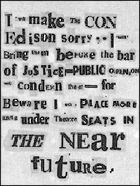
One of Metesky's threatening letters.
Eventually snapping, Metesky planted his first bomb in 1940. It was put in a wooden toolbox and left on a window sill at a Con Edison power plant in Manhattan. Fortunately, it was found before it could go off. Wrapped around the bomb was a hand-written note reading "CON EDISON CROOKS - THIS IS FOR YOU". Because the note was wrapped around the bomb, investigators speculated whether it was an intentional dud since the note would have been destroyed if the bomb went off.
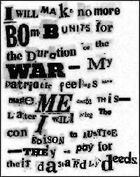
Metesky's "patriotic" letter.
Metesky's next bomb, which had a similar detonation mechanism, was planted near Con Edison's headquarters and was also a dud. When the U.S. entered World War II after the Empire of Japan's attack on Pearl Harbor on December 7, 1941, Metesky sent a letter, again using the signature "F.P.", to the police promising not to make any more bombs while the U.S. were involved in the war because his "patriotic feelings" led him to his decision. Between 1941 and 1951, Metesky, true to his word, did not make any bombs, though he kept sending letters to newspapers, the police, private civilians and, of course, Consolidated Edison.
Between 1951 and 1956, Metesky placed several bombs in public places, such as phone booths, libraries, and public transportation centers, leaving the bombs in storage lockers and public restrooms. Among his most notable attacks were when he planted bombs in movie theaters, cutting open the chairs' upholstery and concealing the bombs inside. The first of this string of bombs, which was the first bomb planted by Metesky was placed in an ash tray at Grand Central Terminal on March 29, 1951, and was detonated by the bomb squad. In April and August, two more non-harmful bombs in placed in phone booths went off at the New York Public Library and Grand Central, respectively. His next bomb exploded in a phone booth near the Consolidated Edison headquarters and also harmed no-one. He also mailed a bomb, which didn't explode, to the company itself. In October, he sent a letter to the New York Herald Tribune, vowing to continue exploding bombs until Con Edison was "brought to justice" for "their dastardly acts against [him]". The letter also directed them to two more bomb locations, only one of which concealed a bomb.
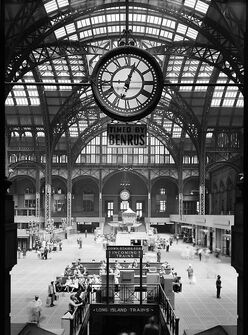
Pennsylvania Station.
In 1952, Metesky planted one bomb in March, June, and December. The first exploded in a phone booth at the Port Authority Bus Terminal, harming no-one. The two latter bombs were planted in seats at a theater on Lexington Avenue. The December bombing injured one person and was Metesky’s first human casualty. Though the police tried to suppress keep the case quiet, the public was becoming aware that the "Mad Bomber" was on the loose. In 1953, Metesky is performed bombings at Radio City Music Hall and the Capitol Theater. An undetonated bomb was also found in a locker at Pennsylvania Station. None of the bombings that year injured anyone. His next bombing, in a men's room at Grand Central Terminal in 1954, injured three men. The same year, a bomb exploded in a phone booth and injured no-one. Another bomb was found in a public phone taken down for repairs. On November 7, a bomb concealed in the seat of a movie theater exploded during a screening of White Christmas, injuring four people. In 1955, five bombs were detonated, none of them injuring anyone.
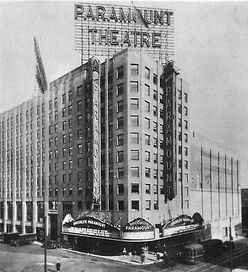
Brooklyn's Paramount Theatre.
One bomb at Radio City Music Hall and one in Roxy Theater were found and didn't go off. In 1956, a 74-year old bathroom attendant at Pennsylvania Station was seriously injured when a bomb blew up in a toilet bowl when the victim tried to clean it. When a bomb was found at the RCA Building in Rockefeller Center, a guard, not realizing that it was an explosive device, thought it could be used for plumbing and brought it home, where it exploded without injuring anyone. On December 2, six people were injured when a bomb went off at the Paramount Theater. The next day, Police Commissioner Stephen P. Kennedy ordered a massive manhunt due to the great media coverage the incident received. On December 24, a bomb was found at the New York Public Library and disarmed. Metesky later said that it was "by the hand of God" that nobody was killed by any of his bombs, though he also claimed he designed the bombs specifically to be non-lethal.
Capture and Incarceration[]
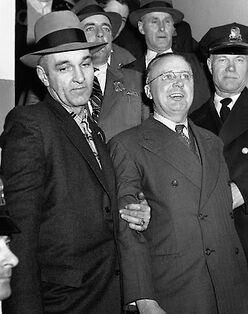
Metesky during his arrest, as predicted was wearing a "buttoned double-breasted jacket".
Throughout Metesky's campaign of bombings, the police had investigated his crimes thoroughly, but come up empty. Though his letters indicated clearly that the perpetrator held a deep grudge against Consolidated Edison, no good suspect could be found even through lawsuit records, mental hospital records, etc. People kept making reports about neighbors or colleagues they suspected. False bomb reports and phony copycats were also responsible for distracting the police and wasting their time and resources. Because traditional means of investigation led nowhere, police captain John Cronin contacted Dr. James A. Brussel, a criminologist and psychiatrist, and asked him for advice in 1956. Brussel developed a detailed offender profile of the Mad Bomber based on the evidence and the letters. This was one of the first and most successful uses of offender profiling. The profile was publicized on December 25 the same year all over the media and led to even more fake bomb threats, hoaxes and false confessions. On December 26, the New York American News Journal published a letter composed by the police urging the bomber to turn himself in, promising that he would be given a fair trial. Metesky replied the next day, saying he would not surrender.
On January 18, 1957, a Consolidated Edison clerk named Alice Kelly was going over worker's compensation claims and, having read the profile, noticed that Metesky's letters used phrases much like the ones the Mad Bomber had used in his letters, including "dastardly deeds". When an injury date mentioned in a Bomber letter matched the date of Metesky's workplace injury, a warrant was issued. New York police officers, accompanied by their Waterbury counterparts, visited Metesky with a search warrant shortly before midnight on January 21. In his home in Waterbury, they found bomb-making components, socks like the ones he had used to conceal the bombs. When asked what "F.P." stood for, Metesky claimed it stood for "Fair Play". Getting dressed to go to the police station, he put on a double-breasted suit and buttoned it; Brussel had predicted that the Mad Bomber would wear that exact kind of jacket when he was arrested. At the station, Metesky recounted his many bomb locations, never actually using the word "bomb", calling his explosive devices "units". He confessed to the 32 bombs and was indicted on a total of 47 charges for attempted murder, damaging a building by explosion, malicious endangerment of life and carrying concealed weapons. After a court psychiatrist found Metesky to be a paranoid schizophrenic, he was deemed mentally unfit to stand trial and placed in The Matteawan Hospital for the Criminally Insane in Beacon, New York. Though his therapy led nowhere, his physical treatment did wonders for his tuberculosis and after a year and a half, his condition had greatly improved. On December 13, 1973, he was released on the one condition that he make regular visits to a mental health clinic near where he lived. He moved back into his Waterbury home and remained there until he died in 1994, aged 90.
Modus Operandi[]
Metesky's bombs were pipe bombs filled with gunpowder. Many of them used timers made of flashlight batteries and cheap pocket watches. He often concealed them in wool socks, which he also sometimes used to suspend them. The bombs were often signed "FP", which Metesky later claimed stood for "Fair Play".
Profile[]
Brussel's profile of the Mad Bomber was as follows, beyond his hatred of Consolidated Edison:
Male, as historically most bombers were male. Well proportioned and of average build, based on studies of hospitalized mental patients. Forty to fifty years old, as paranoia develops slowly. Precise, neat and tidy, based on his letters and the workmanship of his bombs. An exemplary employee, on time and well-behaved. A Slav, because bombs were favored in Middle Europe. A Catholic, because most Slavs were Catholic. Courteous but not friendly. Has a good education but probably not college. Foreign-born or living in a community of the foreign-born – the formal tone and old-fashioned phrasing of the letters sounded to Brussel as if they had been written or thought out in a foreign language and then translated into English. Based on the rounded letter "w's" of the handwriting, believed to represent breasts, and the slashing and stuffing of theater seats, Brussel thought something about sex was troubling the bomber, possible an Oedipus complex — loving his mother and hating his father and other authority figures. A loner, no friends, little interest in women, possibly a virgin. Unmarried, perhaps living with an older female relative. Probably lives in Connecticut, as Connecticut has high concentrations of Slavs, and many of the bomber's letters were posted in Westchester County, midway between Connecticut and New York City.
Brussel also correctly predicted that the Bomber, when being arrested, would be wearing a buttoned double-breasted jacket.
Known Victims[]
- November 16, 1940: The first Consolidated Edison bomb (no casualties; the bomb was a dud, possibly an intentional one)
- September 1941: The 4 Irving Place bomb (no casualties; the bomb was dropped without a lit fuse)
- 1951:
- March 29: The first Grand Central Terminal bomb (no casualties)
- April: The first New York Public Library bomb (no casualties)
- August: The second Grand Central Terminal bomb (no casualties)
- August-September:
- The second Consolidated Edison bomb (no casualties)
- The third Consolidated Edison bomb (a mail-bomb; no casualties; the bomb was a dud)
- October 22: The first Paramount Theater bomb (no casualties; the bomb was found and disabled)
- November 28: The IRT 14th Street subway station bomb (no casualties)
- 1952:
- March 19: The first Port Authority Bus Terminal bomb (no casualties)
- June: The first Loew's theater bomb (no casualties)
- December: An unnamed victim (injured by the second Loew's theater bomb)
- Unspecified dates in 1953:
- The first Radio City Music Hall bomb (no casualties)
- The Capitol Theater bomb (no casualties)
- The third Grand Central Terminal bomb (no casualties)
- The first Pennsylvania Station bomb (no casualties; the bomb was a dud)
- Unspecified dates in 1954:
- Three unnamed men injured by the fourth Grand Central Terminal bomb
- The second Port Authority Bus Terminal bomb (no casualties)
- The second Pennsylvania Station bomb (no casualties; the bomb was found when the locker it was contained in was moved)
- November 7: Four unnamed patrons (all injured by the second Radio City Music Hall bomb)
- Unspecified dates in 1955:
- The IRT Sutter Avenue subway station bomb (no casualties)
- The Macy's department store bomb (no casualties)
- The third and fourth Pennsylvania Station bombs (no casualties from either bombing)
- The third Radio City Music Hall bomb (no casualties; the bomb was found)
- The Roxy Theater bomb (no casualties; the bomb was a dud)
- The second Paramount Theater bomb (no casualties)
- December: The fifth Grand Central Terminal bomb (no casualties)
- 1956:
- Unspecified date: An unnamed attendant, 74 (seriously injured by the fifth Pennsylvania Station bomb)
- Unspecified date: The RCA building bomb (no casualties; the bomb exploded in New Jersey when taken home by a security guard)
- December 2: Six unnamed people (all injured by the third Paramount Theater bomb)
- December 24 (date of discovery): The second New York Public Library bomb (planted months prior; no casualties)
- December 24-29 (date of discovery unspecified further): The fourth Paramount Theater bomb (planted months prior; no casualties)
- Notes: A third bomb was discovered in Loew's theater eight months after Metesky's arrest, while two more bombs remain unaccounted for to this day. Those two bombs were said to have been planted at a Consolidated Edison site located at the East River and an Embassy Theater. Authorities are certain that there are no bombs planted there.
On Criminal Minds[]
- Season One
- "Extreme Aggressor" - The first real-life criminal to be referenced in the series, Metesky was first brought up when Morgan quizzes a group of FBI trainees about criminals; one of the trainees remarks that Metesky never actually killed anyone.
- "Poison" - While never directly mentioned or referenced in the episode, Metesky appears to be an inspiration for the episode's unsub, Edward Hill - Both are attempted mass murderers fired from their places of employment without due payment, targeted their places of employment out of revenge, left the weapons they used at the offices of their employers, targeted random victim in public places, were profiled as being middle-aged and to be found in employment records, and bragged about their crimes once captured.
- "A Real Rain" - Metesky was mentioned again during a dinner conversation; Gideon brings him up as one of the first cases of criminal profiling (as well as an example of successful offender profiling), referring to how spot-on Brussel's profile was.
- Season Five
- "Nameless, Faceless" - While never directly mentioned or referenced in the episode, Metesky appears to be an inspiration for the episode's unsub, Patrick Meyers - Both are spree offenders (killer in Meyers' case, bomber in Metesky's) motivated by revenge, were profiled as unemployed, suffered a personal loss that triggered their sprees (Meyers lost his son in a car accident, Metesky was fired form getting sick on the job and being denied compensation), sent threatening letters forewarning more crimes, named the parties they held accountable in demands for justice during their threats, and marked their crimes with a two-letter abbreviation alluding to their motives (Meyers used "LC" for "Living Children" to denote his son's death he blamed on the medical team, Metesky used "FP" for "Fair Play" as a taunt about his revenge).
- Novels
- Killer Profile - A similar reference to Metesky was also made in this novel.
On Criminal Minds: Suspect Behavior[]
- Season One
- "Here is the Fire" - Metetsky was mentioned as an example of bombers.
Sources[]
